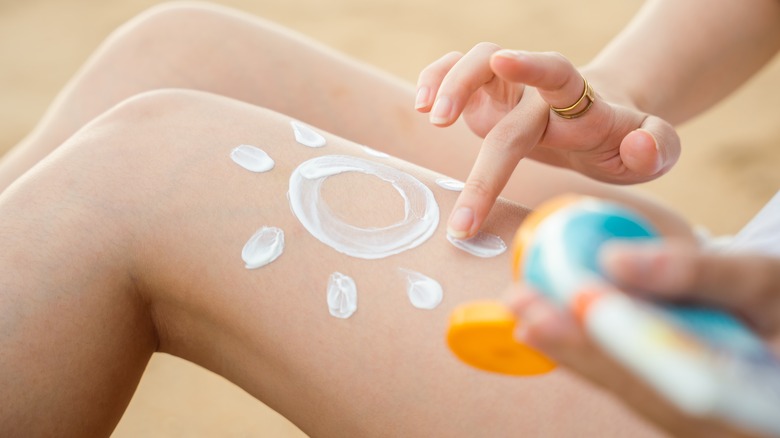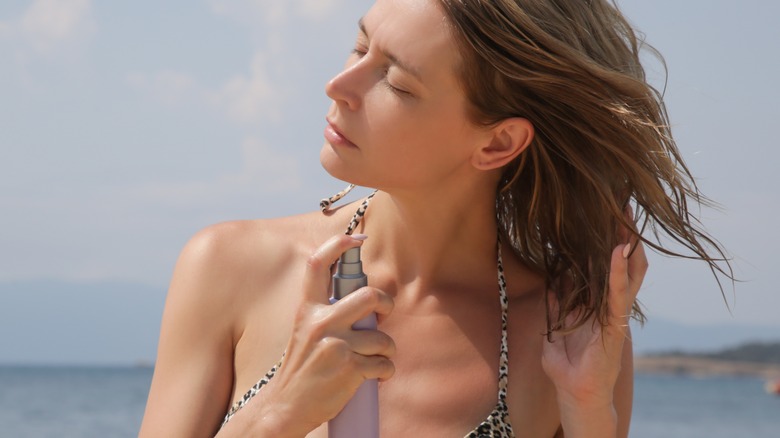Curious About How Much Sunscreen To Apply To Your Body? Here's A Rule To Follow
There's a fine line between healthy skin and unhealthy skin, and that line has a lot to do with sun protection factor (SPF). Those who put a great premium on their skincare are no strangers to the importance of wearing sunscreen. Sunscreens are crucial in preventing damaging ultraviolet (UV) radiation from penetrating the skin and causing damage to skin cells, elastin, and collagen in the skin. Wearing sunscreen helps to prevent sunburn, minimize risks of hyperpigmentation, and diminish signs of skin aging, such as liver spots and fine lines.
According to The Skin Cancer Foundation, using sunscreen with an SPF of 15 or higher on a daily basis can reduce your risks of contracting skin cancer — such as squamous cell carcinoma and melanoma by 40% and 50%, respectively. Obviously, we should make it a habit to slather up with sunscreen before walking out the door, rain or shine. However, sun protection doesn't end with sunscreen application. How to wear sunscreen properly and achieve the coverage the skin needs is another story. So, can we ever wear too much or too little sunscreen? Here are some insights.
You might be under-applying sunscreen
According to Dr. Darrel Rigel (via CBS News), clinical professor of dermatology at NYU, a typical error that many individuals make with SPF usage is using only 25 to 50% of the recommended amount of sunscreen. For even coverage, The American Academy of Dermatology recommends using enough sunscreen to cover the skin that's not covered by clothing. For most adults, 1 ounce of sunscreen is sufficient to completely cover their body.
In the opinion of dermatologist Marisa Garshick, you need to use 2 milligrams of sunscreen per square centimeter of the skin to reach the amount of protection indicated on a sunscreen bottle. Generally speaking, the amount of sunscreen you use for the body must be enough to fill a shot glass or 2 tablespoons. "For the face, it is recommended to apply a nickel-sized dollop — the equivalent of two finger lengths, which is also equivalent to half a teaspoon, to the face and neck combined," Garshick tells Allure.
If you're using stick sunscreens, Garshick advises applying it four times back and forth before rubbing it in. For spraying sunscreen, spritz the formula to your hand first and apply it to your face until it glistens, then rub it in to ensure a uniform layer of coverage, The American Academy of Dermatology advises. Before heading outside, apply sunscreen on dry skin 15 minutes beforehand and reapply every two hours while outdoors as SPF melts away as you perspire.
How much SPF do I need?
The SPF number lets you know how much protection you get against sunburn. UV rays are classified into two types: UVA and UVB. UVA can penetrate the skin like a hot knife through butter, while UVB can damage the top layer of the skin. The SPF number only refers to protection against UVB radiation. For example, SPF15 filters out 93% of UVB radiation, while 96.7% of UVB rays are blocked by SPF30. SPF50 filters out 98% of UVB radiation, while SPF100 filters out 99% of UVB radiation.
Buying sunscreen only on the basis of a high SPF might cause you to get complacent and overlook factors like sun intensity and the coverage achieved after application. "A high SPF can give people a false sense of security," dermatologist Saira George tells MD Anderson Cancer Center. "There are a lot of limitations with SPF numbers. People often mistakenly think they can't get sunburned or they can be out in the sun for much longer than is safe if they put on SPF 100 sunscreen."
In fact, a sunscreen with SPF 30 is good enough as long as you apply it evenly and reapply every two hours. A higher SPF, on the other hand, can only give you a little more protection just in case you under-apply or you forget to reapply when out in the sun or the water. You won't get significantly higher sun protection with higher SPF.


